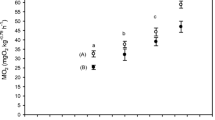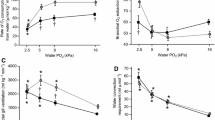Abstract
Oxygen consumption rates were measured individually for mixed groups of male, female, and immature striped bass,Morone saxatilis, in filtered Patuxent River, Maryland, water and in filtered water containing suspensions of either fuller’s earth or Patuxent River sediment. Oxygen consumption was determined at fixed swimming speeds at two temperatures, 15 and 22.5°C. Oxygen consumption of striped bass in filtered 15°C water increased as swimming speed increased. At 22.5°C, the same range of swimming speeds had no effect on rates of oxygen consumption. Similar data were obtained with fish swimming at the same speeds in water containing 0.79 g per liter fuller’s earth particles (15°C), and among those swimming at 31.7 and 49.0 cm per s in water containing 1.32 g per 1 Patuxent River sediment (22.5°C). Male and female striped bass respiration rates were similar under all test conditions. At 15°C, striped bass oxygen consumption rates during exposure to fuller’s earth while swimming at 8.6 and 31.7 cm per s did not differ from rates of fish swimming at the same speeds in filtered water. At 49.0 cm per s, rates were significantly depressed. Respiration rates of fish exposed to Patuxent River sediment at 22.5°C while swimming at 31.7 and 49.0 cm per s were significantly lower than those of fish in filtered water. Respiratory response of striped bass to suspended particle stress was manifested by depressed oxygen consumption. This is considered a short-term response to an acute stress. This response and the potential for hematological response to chronic suspended particle stress are discussed.
Similar content being viewed by others
Literature cited
American Society of Testing Materials. 1968. Particle size distribution of coating clay. Publ. No. T 649 suppl. 68.
Beamish, F. W. H. 1964a. Influence of starvation on standard and routine oxygen consumption.Trans. Am. Fish. Soc. 93:103–107.
Beamish, F. W. H. 1964b. Seasonal changes in the standard rate of oxygen consumption of fishes.Can. J. Zool. 42:189–194.
Brett, J. R. 1964. The respiratory metabolism and swimming performance of young sockeye salmon.J. Fish. Res. Board Can. 21:1183–1226.
Brett, J. R. 1965. The relation of size to rate of oxygen consumption and sustained swimming speed of sockeye salmon (Oncorhynchus nerka).J. Fish. Res. Board Can. 22:1491–1501.
Dickson, I. W., andR. H. Kramer. 1971. Factors influencing scope for activity and active and standard metabolism of rainbow trout (Salmo gairdneri).J. Fish. Res. Board Can. 28:587–596.
EIFAC (European Inland Fisheries Advisory Commission). 1964. Water quality criteria for European freshwater fish. Report on finely divided solids and inland fisheries. EIFAC Tech. Pap. No. 1, 21 p.
Ellis, M. M. 1936. Erosion silt as a factor in aquatic environments.Ecology 17:29–42.
Ellis, M. M. 1937. Detection and measurement of stream pollution.Bull. U.S. Bur. Fish. 48:365–473.
Farmer, G. J., andF. W. H. Beamish. 1969. Oxygen consumption ofTilapia nilotica in relation to swimming speed and salinity.J. Fish. Res. Board Can. 26:2807–2821.
Hassler, T. J. 1970. Environmental influences on early development and year class strength of northern pike in Lakes Oahe and Sharpe, S.D..Trans. Am. Fish. Soc. 99:369–375.
Herbert, D. W. M., J. S. Alabaster, M. C. Dart, andR. Lloyd. 1961. The effect of china-clay wastes on trout streams.Int. J. Air Wat. Poll. 5:56–74.
Herbert, D. W. M., andJ. C. Merkens. 1961. The effect of suspended mineral solids on the survival of trout.Int. J. Air Wat. Poll. 5:46–55.
Horkel, J. D., andW. D. Pearson. 1976. Effects of turbidity on ventilation rates and oxygen consumption of green sunfish,Lepomis cyanellus.Trans. Am. Fish. Soc. 105:107–113.
MacLeod, J. C., andL. L. Smith, Jr. 1966. Effect of pulpwood fiber on oxygen consumption and swimming endurance of the fathead minnow,Pimephales promelas.Trans. Am. Fish. Soc. 95:71–84.
Moore, P. G. 1977. Inorganic particulate suspensions in the sea and their effects on marine animals.Oceanogr. Mar. Biol. Annu. Rev. 15:225–363.
Neumann, D. A., J. M. O’Connor, J. A. Sherk, andK. V. Wood. 1975. Respiratory and hematological responses of oyster toadfish (Opsanus tau) to suspended solids.Trans. Am. Fish. Soc. 104:775–781.
O’Connor, J. M., D. A. Neumann, and J. A. Sherk, Jr. 1976. Lethal effects of suspended sediments on estuarine fish. U.S. Army Corps Eng., Coastal Eng. Res. Cent., Fort Belvoir, Va. Tech. Pap. No. 76-20. 38 p.
O’Connor, J. M., D. A. Neumann, and J. A. Sherk, Jr. 1977. Sublethal effects of suspended sediments on estuarine fish. U.S. Army Corps Eng., Coastal Eng. Res. Cent., Fort Belvoir, Va. Tech. Pap. No. 77-3. 90 p.
Peddicord, R. K., and V. A. McFarland. 1978. Effects of suspended dredged material on aquatic animals. U.S. Army Corps Eng., Dredged Material Res. Prog., Vicksburg, Miss. Tech. Rept. D-78-29. 117 p.
Prosser, C. L., L. M. Barr, R. D. Pinc, andC. Y. Lauer. 1957. Acclimation of goldfish to low concentrations of oxygen.Physiol. Zool. 30:137–141.
Ritchie, J. C. 1972. Sediment, fish, and fish habitat.J. Soil Water Conserv. 27:124–125.
Rogers, B. A. 1969. Tolerance levels of four species of estuarine fishes to suspended mineral solids. M.S. Thesis, Univ. Rhode Island, Kingston. 60 p.
Sheldon, J. M., andR. D. Pollock. 1966. Siltation and egg survival in incubation channels.Trans. Am. Fish. Soc. 95:183–187.
Smith, L. L., R. H. Kramer, andD. M. Oseid. 1966. Long-term effects of conifer-groundwood paper fiber on walleyes.Trans. Am. Fish. Soc. 95:60–70.
Snedecor, G. W., andW. G. Cochran. 1967. Statistical Methods. 6th Edition. Iowa State Univ. Press, Ames. 593 p.
Southgate, B. A. 1962. Water pollution research, 1959.In L. Klein (ed.), River Pollution. II. Causes and Effects. Butterworth, London. 456 p.
Wallen, I. E. 1951. The direct effect of turbidity on fishes.Bull. Okla. Agric. Mech. Coll., Biol. Ser. 48:1–27.
Wohlschlag, D. E. 1962. Antarctic fish growth and metabolic differences related to sex.Ecology 43:589–597.
Wohlschlag, D. E., andR. O. Juliano. 1959. Seasonal changes in bluegill metabolism.Limnol. Oceanogr. 4:195–209.
Author information
Authors and Affiliations
Additional information
Contribution No. 1019, Center for Environmental and Estuarine Studies of the University of Maryland.
Rights and permissions
About this article
Cite this article
Neumann, D.A., O’Connor, J.M., Sherk, J.A. et al. Respiratory response of striped bass (Morone saxatilis) to suspended solids. Estuaries 5, 28–39 (1982). https://doi.org/10.2307/1352214
Issue Date:
DOI: https://doi.org/10.2307/1352214




